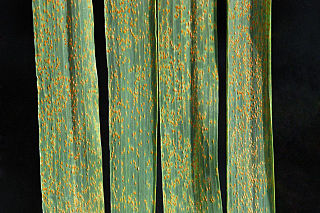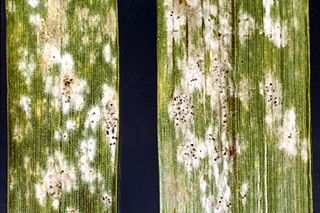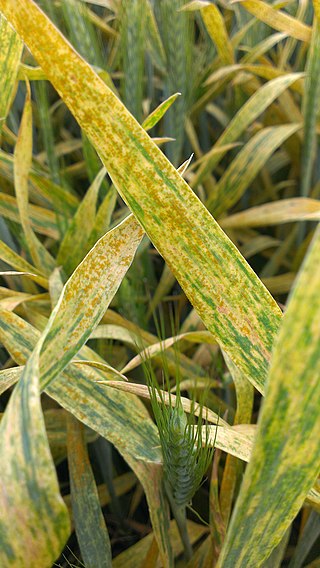Related Research Articles

Fusarium ear blight (FEB), is a fungal disease of cereals, including wheat, barley, oats, rye and triticale. FEB is caused by a range of Fusarium fungi, which infects the heads of the crop, reducing grain yield. The disease is often associated with contamination by mycotoxins produced by the fungi already when the crop is growing in the field. The disease can cause severe economic losses as mycotoxin-contaminated grain cannot be sold for food or feed.
The cereal grain wheat is subject to numerous wheat diseases, including bacterial, viral and fungal diseases, as well as parasitic infestations.

Wheat leaf rust is a fungal disease that affects wheat, barley, rye stems, leaves and grains. In temperate zones it is destructive on winter wheat because the pathogen overwinters. Infections can lead up to 20% yield loss. The pathogen is a Puccinia rust fungus. It is the most prevalent of all the wheat rust diseases, occurring in most wheat-growing regions. It causes serious epidemics in North America, Mexico and South America and is a devastating seasonal disease in India. P. triticina is heteroecious, requiring two distinct hosts.

Blumeria graminis is a fungus that causes powdery mildew on grasses, including cereals. It is the only species in the genus Blumeria. It has also been called Erysiphe graminis and Oidium monilioides or Oidium tritici.

Eyespot is an important fungal disease of wheat caused by the necrotrophic fungus Tapesia yallundae and Tapesia acuformis. It is also called Strawbreaker. Eyespot is more severe where wheat is grown continuously and when the weather is cool and moist. Treating crops against eyespot with fungicide costs millions to farmers and is complicated by the pathogen becoming resistant to the more commonly used fungicides. Severe cases of the disease can reduce yield by up to 40%. It is most common in temperate regions such as North and South America, Europe, Australia, New Zealand and Africa.

Triticeae is a botanical tribe within the subfamily Pooideae of grasses that includes genera with many domesticated species. Major crop genera found in this tribe include wheat, barley, and rye; crops in other genera include some for human consumption, and others used for animal feed or rangeland protection. Among the world's cultivated species, this tribe has some of the most complex genetic histories. An example is bread wheat, which contains the genomes of three species with only one being a wheat Triticum species. Seed storage proteins in the Triticeae are implicated in various food allergies and intolerances.
Rhynchosporium secalis is an ascomycete fungus that is the causal agent of barley and rye scald.

The fungus Cochliobolus sativus is the teleomorph of Bipolaris sorokiniana (anamorph) which is the causal agent of a wide variety of cereal diseases. The pathogen can infect and cause disease on roots, leaf and stem, and head tissue. C. sativus is extremely rare in nature and thus it is the asexual or anamorphic stage which causes infections. The two most common diseases caused by B. sorokiniana are spot blotch and common root rot, mainly on wheat and barley crops.
Alternaria triticina is a fungal plant pathogen that causes leaf blight on wheat. A. triticina is responsible for the largest leaf blight issue in wheat and also causes disease in other major cereal grain crops. It was first identified in India in 1962 and still causes significant yield loss to wheat crops on the Indian subcontinent. The disease is caused by a fungal pathogen and causes necrotic leaf lesions and in severe cases shriveling of the leaves.

Gibberella zeae, also known by the name of its anamorph Fusarium graminearum, is a fungal plant pathogen which causes fusarium head blight (FHB), a devastating disease on wheat and barley. The pathogen is responsible for billions of dollars in economic losses worldwide each year. Infection causes shifts in the amino acid composition of wheat, resulting in shriveled kernels and contaminating the remaining grain with mycotoxins, mainly deoxynivalenol (DON), which inhibits protein biosynthesis; and zearalenone, an estrogenic mycotoxin. These toxins cause vomiting, liver damage, and reproductive defects in livestock, and are harmful to humans through contaminated food. Despite great efforts to find resistance genes against F. graminearum, no completely resistant variety is currently available. Research on the biology of F. graminearum is directed towards gaining insight into more details about the infection process and reveal weak spots in the life cycle of this pathogen to develop fungicides that can protect wheat from scab infection.
Crown rot of wheat is caused by the fungal pathogen Fusarium pseudograminearum. F. pseudograminearum is a member of the fungal phylum Ascomycota and is also known as Gibberella coronicola (teleomorph). It is a monoecious fungus, meaning it does not require another host other than wheat to complete its life cycle. Although F. pseudograminearum can produce both anamorphic and teleomorphic states, the teleomorph is usually not present for crown rot of wheat. This Fusarium species has, until recently, been considered to be the same as the species known as Fusarium graminearum due to many similar characteristics. One of the only differences between the two species is that F. pseudograminearum lacks its sexual stage on the wheat host.

Zymoseptoria tritici, synonyms Septoria tritici, Mycosphaerella graminicola, is a species of filamentous fungus, an ascomycete in the family Mycosphaerellaceae. It is a wheat plant pathogen causing septoria leaf blotch that is difficult to control due to resistance to multiple fungicides. The pathogen today causes one of the most important diseases of wheat.
Puccinia striiformis is a fungal species and plant pathogen. It causes stripe rust on wheat, but has other hosts as well. The species is common in Europe and in more recent years has become a problem in Australia. Crop infections can cause losses of up to 40%, and the fungus will infect both winter wheat and spring wheat.

Tilletia caries is a basidiomycete that causes common bunt of wheat. The common names of this disease are stinking bunt of wheat and stinking smut of wheat. This pathogen infects wheat, rye, and various other grasses. T. caries is economically and agriculturally important because it reduces both the wheat yield and grain quality.
Wheat yellow leaf virus (WYLV) is a wheat (Triticum spp. L.), barley (Hordeum vulgare L.), rye (Secale cereale M.Bieb.), and oat (Avena sativa L.) pathogenic virus of the family Closteroviridae. WYLV virions are 1600–1850 nm in length and 10 nm in diameter. The virus, like other members of its genus, is transmitted by aphids. Identified vectors include Rhopalosiphum padi L. and R. maidis Fitch. (Aphididae). The virus has been identified in crop plants in Japan, China, and Italy. Native host plants include Italian ryegrass (Festuca perennis Lam.) in Europe and Agropyron tsukushiense var. transiens Ohwi in Japan. The virus proliferates in the phloem of its host plants, interfering with the plant's ability to produce sufficient chlorophyll (Chlorosis), causing the leaves to yellow and the plant to die.

Wheat yellow rust, also known as wheat stripe rust, is one of the three major wheat rust diseases, along with stem rust of wheat and leaf rust.
Ruth Florence Allen (1879–1963) was an American botanist and plant pathologist and the first woman to earn her Ph.D. in botany from the University of Wisconsin. Her doctorate research focused on the reproduction and cell biology of ferns, particularly the phenomenon of apogamy. Later in her career, Allen shifted her focus to plant pathology. Her major contribution to the field of mycology was furthering the understanding of rust fungi, a group of economically important plant pathogens. Allen completed many studies on Puccinia graminis, once considered a catastrophically damaging disease-causing agent in cereal crops before the discovery of current management measures.

Mary Dilys Glynne was a British plant pathologist and mountaineer.

Frances Joan Harvey Moore, OBE was a British plant pathologist, science administrator and conservationist.
Ernest Robert Sears was an American geneticist, botanist, pioneer of plant genetics, and leading expert on wheat cytogenetics. Sears and Sir Ralph Riley (1924–1999) are perhaps the two most important founders of chromosome engineering in plant breeding.
References
- ↑ Wallwork, H.; B. Spooner (1988). "Tapesia yallundae – the teleomorph of Pseudocercosporella herpotrichoides". Transactions of the British Mycological Society. 91 (4): 703–705. doi:10.1016/S0007-1536(88)80050-0.
- 1 2 Wiese, M.V. (1987). Compendium of wheat diseases. American Phytopathological Society. p. 124.
- ↑ King, Amber C. (1990). "Observations of apothecia of Tapesia yallundae and the cultural phenotypes of their progeny". Plant Pathology. 40 (3): 367–373. doi:10.1111/j.1365-3059.1991.tb02392.x.
- 1 2 Andrade, A. (2005). "Identification of Tapesia yallundae Wallwork & Spooner, teleomorph of Pseudocercosporella herpotrichoides (Fron.) Deighton var. herpotrichoides, the causal agent of eyespot of wheat in southern Chile". Agricultura Técnica. 65 (3): 306–311. doi: 10.4067/S0365-28072005000300008 .
- ↑ Gac, M. L.; F. Montfort; N. Cavelier; A. Sailland (1996). "Comparative study of morphological, cultural and molecular markers for the characterization of Pseudocercosporella herpotrichoides isolates". European Journal of Plant Pathology. 102 (4): 325–337. Bibcode:1996EJPP..102..325G. doi:10.1007/BF01878127. S2CID 2893810.